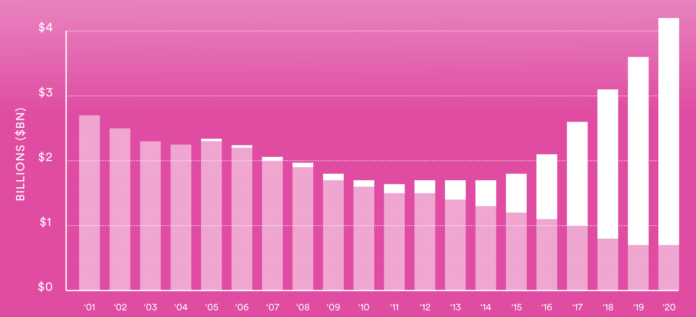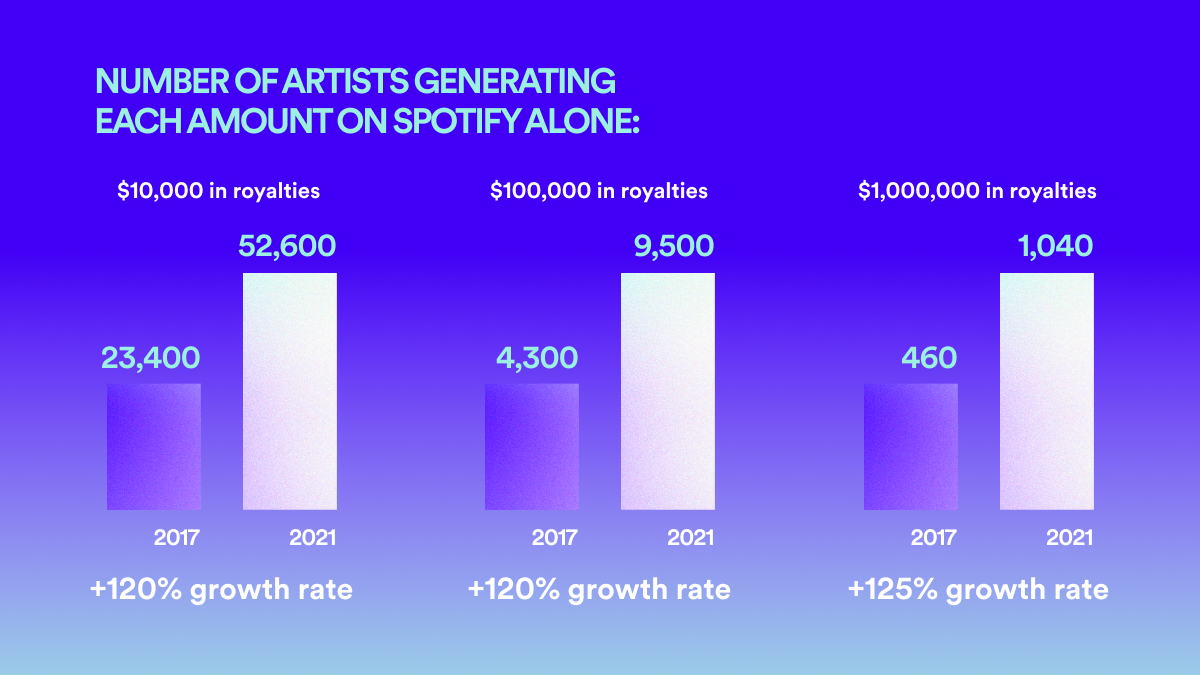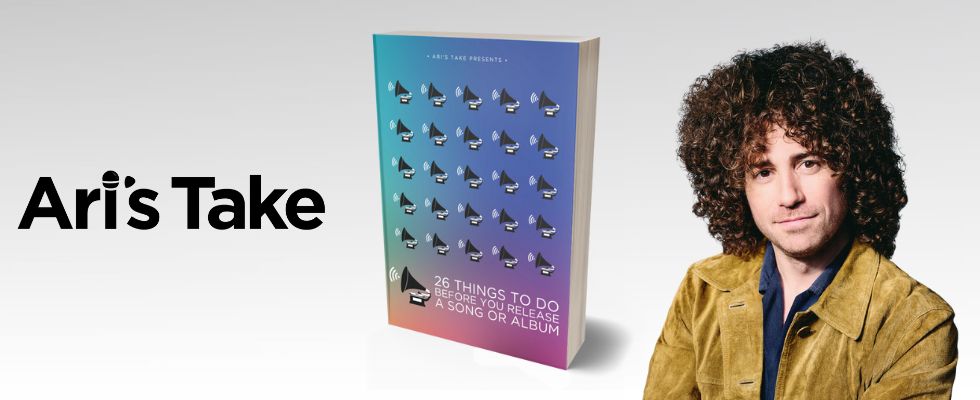Spotify just released their new Loud and Clear report today which profiled a lot of really interesting figures.
The three most surprising things that stuck out to me from this report are:
- How many DIY, self-released artists are earning from Spotify
- There were more musicians in 2021 making money from recorded music than in 2001
- Songwriters are actually making MORE money in the streaming era than in the CD era
Wait what?!
I know, I know. The talking points primarily from the National Music Publishers Association (NMPA) spearheaded by David Israelite is that Spotify hates songwriters and doesn’t pay.
+Should Artists Boycott Spotify Like Neil Young
Unfortunately, many of the loudest voices in the industry over the past decade don’t quite grasp the economics of this new streaming era. And they intentionally like to complicate the issue and confuse musicians for their own agenda. Let’s not forget that the NMPA represents MAJOR publishers who are owned by MAJOR labels.
I think we can all agree that all we want is for artists and songwriters to have successful, long-term careers. And it seems, at least from the data, that streaming is helping in this pursuit.
Let’s unpack some of these revelations, shall we?
15,140 self-released artists made at least $10,000 from Spotify in 2021
My biggest gripe with the 2020 Spotify report was that it didn’t separate the label artists from the self-released artists. So when Spotify says 52,600 artists made at least $10,000, previously we didn’t know how many of them were with labels or not. Now we do.
28% are self-released.
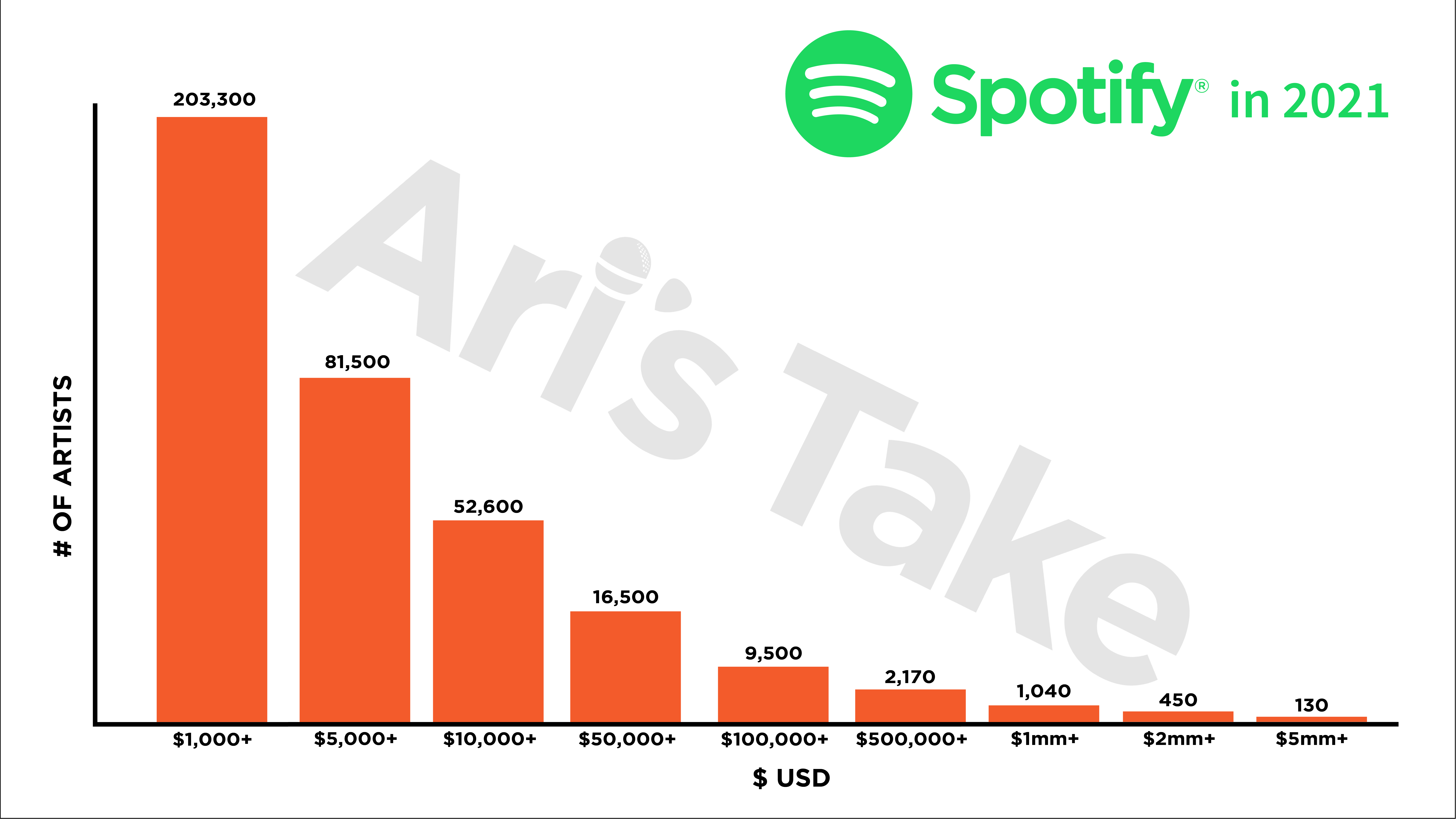
- 203,300 Artists made over $1,000
- 81,500 Artists made over $5,000
- 52,600 Artists made over $10,000
- 16,500 Artists made over $50,000
- 9,500 Artists made over $100,000
- 2,170 Artists made over $500,000
- 1,040 Artists made over $1mm
Now to be clear, these figures are actually the number of artists whose catalogs generated both recording and publishing royalties.
In short, this is the number Spotify paid out for the artists’ work.
When it comes to label artists, we don’t actually know what the artist’s take-home amount is. Indie labels typically offer a 50/50 split. Major labels typically KEEP 82% – and of course only pay out their artists after they recoup their advance/expenses (which almost never happens).
But the self-released artists get to keep either all or most of their money.
DistroKid, Tunecore, Amuse all allow you to keep 100% of your master royalties. Others like CD Baby, Stem, AWAL, Symphonic keep a small commission between 9-15%. Some others work on a hybrid model like UnitedMasters, Songtradr, Landr, Horus where they give the artist the option whether they’d like to pay a small fee and keep 100% or distribute for free and give up a small commission.
+DistroKid vs. Tunecore vs. CD Baby vs. Amuse vs. UnitedMasters… Best Music Distribution Comparison
Spotify pays out 2/3 revenue to rights holders
In other words, Spotify keeps about a 33% commission. For comparison, Apple Music keeps about the same.
About 80% of that money goes to the master rights holders (record labels / Artists) and about 20% goes to the publishing rights holders (publishers / Songwriters).
Why the discrepancy? Why do publishers and songwriters make so much less than labels and artists? Well, it actually has nothing to do with Spotify. It’s because the major labels want to keep it this way.
I think this split should be 50/50 – Publisher/Label (Songwriter/Artist). But of course the major labels don’t want to take a pay cut.
The Music Industry in the CD era favored superstars twice as much as it does today
In this report, Spotify claims:
“At the peak of the CD era, 25% of US sales were accounted for by the top 50 artists. In 2021, only 12% of US streams on Spotify were of the top 50 artists — meaning that revenue opportunities now reach far beyond the biggest stars.”
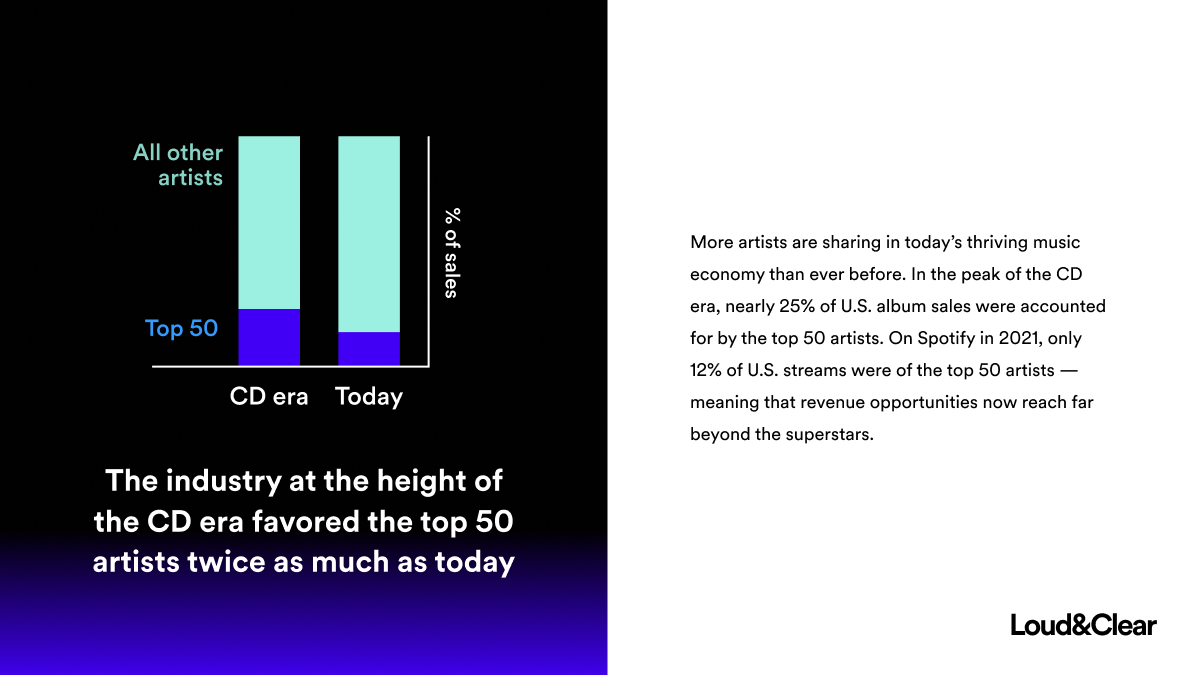
Over 9,000 artists on Spotify have over 1M monthly listeners
This is pretty nuts. I had no idea there were this many artists with over 1 million monthly listeners.
Also, 718,000 songs have over 1 million streams!
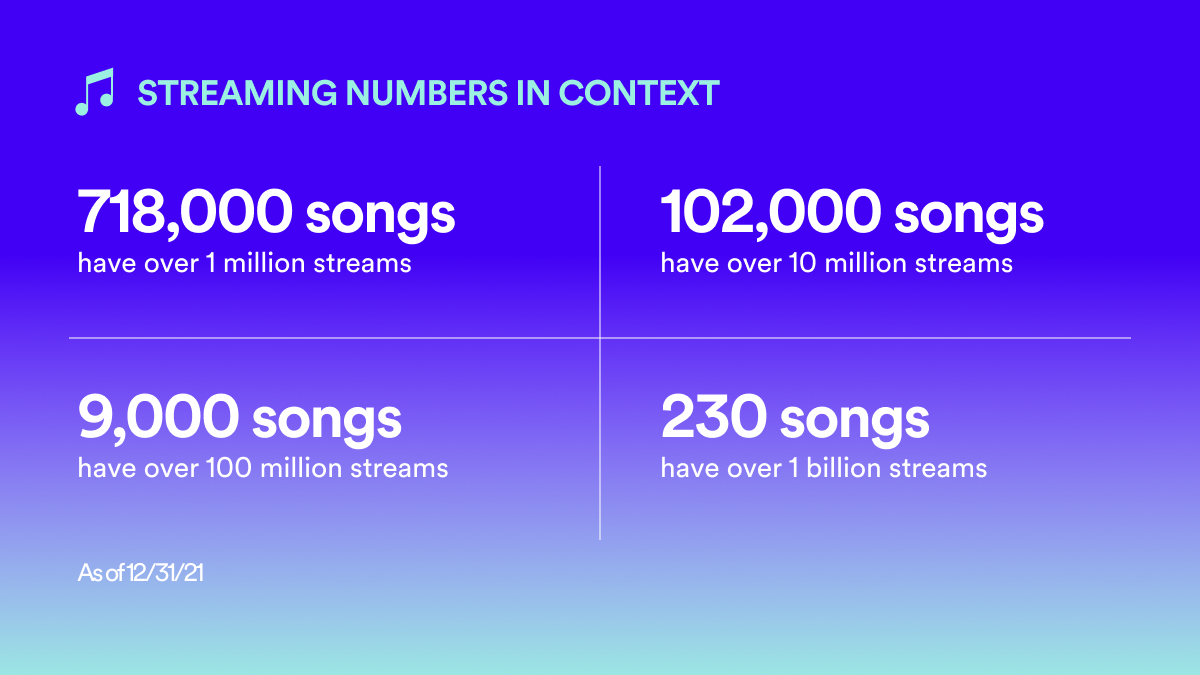
Songwriters earned more revenue in 2020 than they did in 2001.
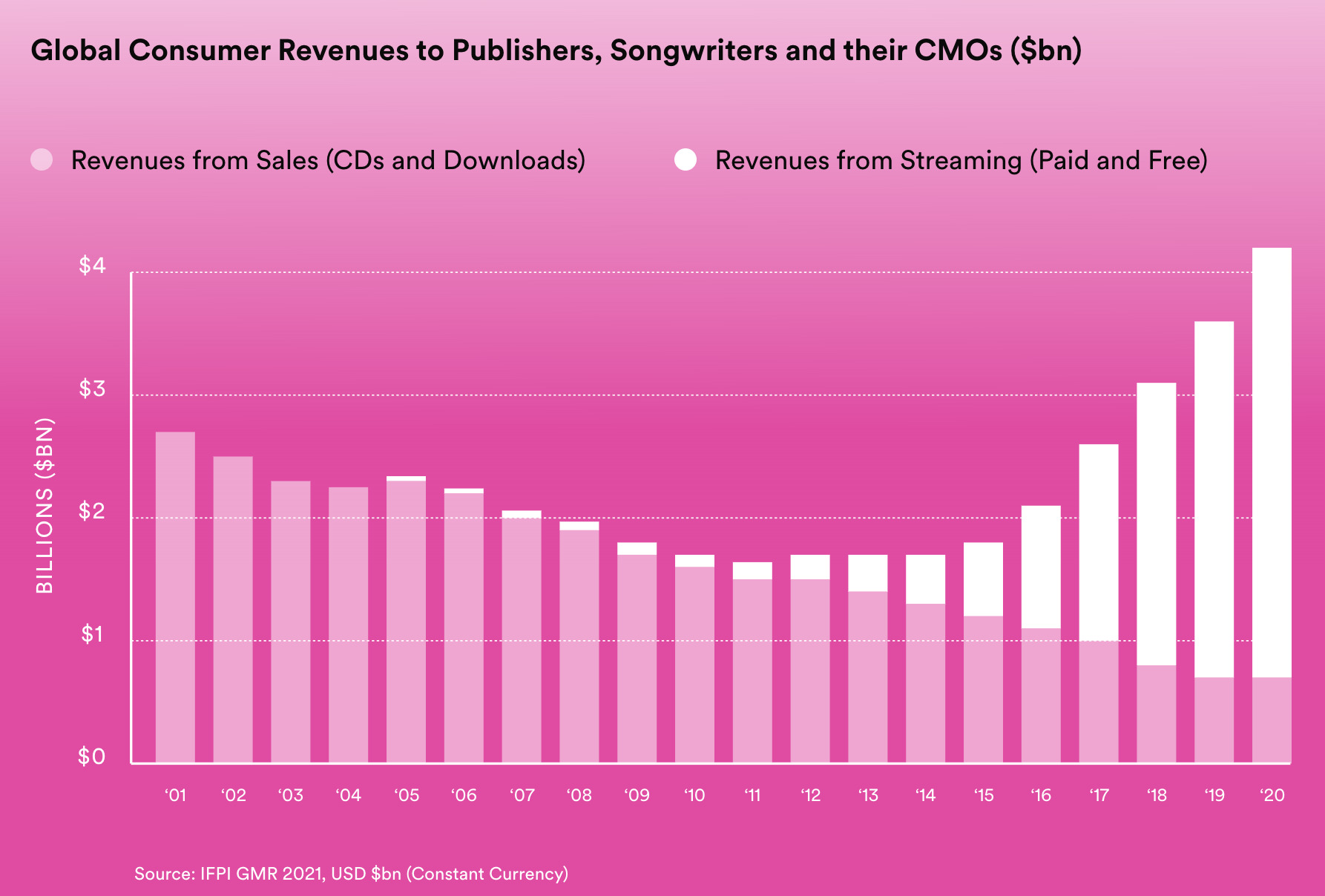
The IFPI report notes that in 2020, publishers, songwriters and their Collective Management Organizations (CMOs – the orgs that collect publishing revenue around the world), earned $3.5 billion from streaming alone. In 2001, it was under $3 billion.
It makes sense, though.
In the CD era, CDs were sold to the public for around $18 at their peak around 2001. The record store would keep about 8 of those dollars (44%), the label would keep the rest (56%) and then pay out that money to publishers/songwriters and their artists (maybe).
On a 10 track CD, songwriters/publishers earned 7.55 cents per song in 2001. So in this scenario, the publishers were paid about 75 cents per CD sale. Which amounts to only 4% of the total! Which is fucking insane.
Under the CD era, publishers made around 4% of the total CD sale. Now, publishers make just over 15% of the total streaming revenues.
In the CD era, labels kept about 56% of the total revenue.
The big issue, now, is if you’re a songwriter who didn’t get the hit on the record, you’re not getting an equal cut. Whereas before, in the CD era, if you wrote some deep cuts on the album, people were buying the full album. Now they’re only really streaming the hits. The money is in the hits now. So, hit songwriters now are earning far more than they did in the CD era. Whereas songwriters without a hit are earning far less.
Should songwriters earn more? Absolutely! Do I think labels and publishers should earn an equal amount from streaming? Yes. This will only happen if the major labels agree to it (which of course, they won’t, because that means they’d have to make less).
+11 Best Music Industry Podcasts for 2022
Lucian Grainge, the CEO of Universal Music Group (the most profitable record label in the world), made $200 million in 2021 – more than the total songwriting revenue for every songwriter in the UK. Come on Lucian, send a bit more of that the songwriters way, please.
There are 200,000 “professional” recording acts on Spotify
Spotify notes (based on much of the criticism they receive) that even though 8 million people have uploaded music to Spotify, only around 200,000 of them are “professional or professionally aspiring recording acts.” Most of these 8 million people have only uploaded a song or two and have never played a gig.
This number is based on a few factors.
1) Do you perform live?
In 2019, 199,000 artists on Spotify played at least 1 gig.
2) Do you have at least 10,000 monthly listeners?
Spotify also notes that there are 165,000 artists with at least 10,000 monthly listeners
+Should Artists Boycott Spotify?
Spotify is willing to switch to a “user-centric” payment model
Now, this is big. SoundCloud, Tidal, and soon Pandora are all moving towards what’s called a “user-centric” payment model. What this means is that if artists have fans who listen to their music a lot, they’ll get paid more.
Now, if a listener spends $10 on a Spotify subscription and listens to just one artist this month, that $10 gets split amongst EVERY stream on Spotify.
Under a user-centric payment model, those $10 would all go to that one artist (less Spotify’s 30% commission).
This would reward the artists with fans.
Many artists get millions of streams, making lots of revenue, but can’t sell 50 tickets to their hometown shows.
How is this possible? Well, songs get included on hot playlists all the time. Which in turn brings them lots of streams (and lots of money). But they have no fans. These listeners are just listening to the playlist, not choosing to listen to the artist specifically.
A user-centric payment model rewards artists with die-hard fans. It wouldn’t matter how many streams you get anymore. There would be no more “per stream” calculation. It would only matter how often your fans listen to you versus everyone else. If a fan paying a $10 subscription fee listens to you and only 9 other artists this month, you’d make $1 that month from that fan. If you have just 1,000 die-hard fans listening to you 1/10 of the time, under the user-centric payment model, you’d make around $1,000 a month in streaming revenue.
“We are willing to make the switch to a user-centric model if that’s what artists, songwriters, and rights holders want to do. “ – Spotify
Spotify told me directly that they’re willing to switch to a user-centric payment model, but they need the labels, publishers and artists to agree on that. Until the labels and publishers see that it won’t hurt their bottom lines, I have a hard time believing they’re willing to rock this cash ship.
+How To Actually Achieve Your Goals in 2022
2021 was the most profitable year for the music industry, ever.
Of the $25.9 billion the music industry made in 2021, $7 billion came from Spotify.
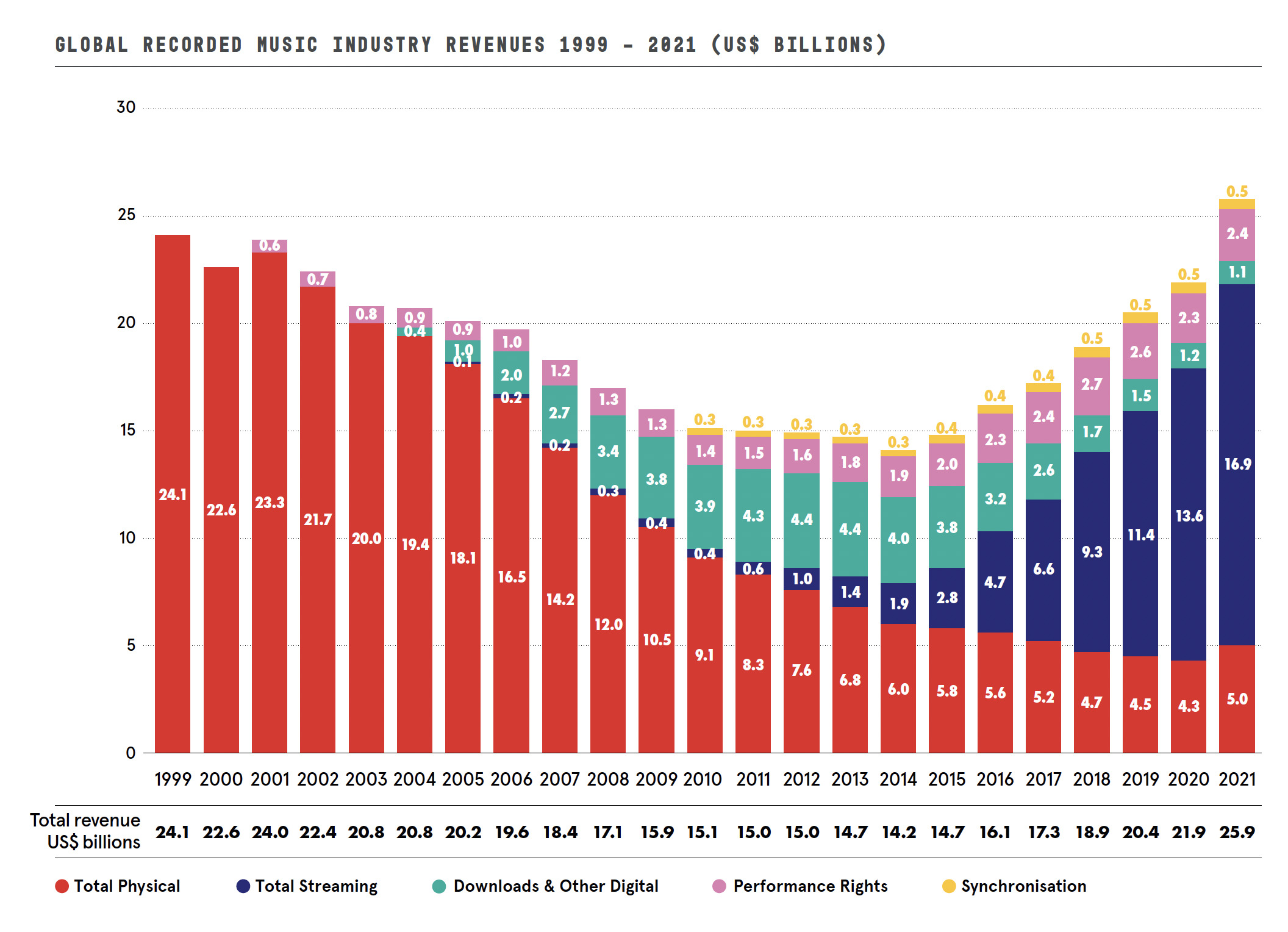
I do need to call Spotify on some shaky math that most likely isn’t accurate. Spotify estimates that over 50,000 artists likely made over $40,000 from streaming overall. This is some serious extrapolation math. Spotify says it accounts for over 20% of recorded music revenue. So, by including the other streaming services, they are estimating that 50,000 artists are earning another 4x what they earn from Spotify streams. (50,000 artists made over $10,000 from Spotify alone).
I highly doubt this is actually accurate. Most Western artists make the majority of their streaming revenue from Spotify. Even Neil Young claimed that over 60% of his revenue came from Spotify.
I’m assuming the other 80% of the recorded music revenue is heavily weighted in other territories with other platforms. And the artists that make up that 80% are not earning equal amounts on Spotify, just like how Western artists aren’t earning equal amounts on Apple Music, Tidal, Pandora, Deezer, JioSaavn, NetEase, QQ, etc.
Check out Spotify’s new Loud and Clear report for yourself here.













